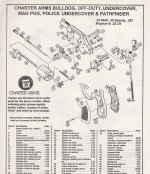I own a Taurus M85 and having seen the lock-work, I know that it is not a copy of S&W revolvers...not even close. However, I have never owned or seen the inside of a Charter Arms revolver, so I am ignorant as to if it is a S&W copy as far as the lock-work is concerned. I would appreciate it if someone who has a Charter Arms would take a picture of a Charter Arms with the side plate off so that I can see for myself what it looks like. The curiosity is killing me.
You are using an out of date browser. It may not display this or other websites correctly.
You should upgrade or use an alternative browser.
You should upgrade or use an alternative browser.
Charter Arms = S&W lockwork copy?
- Thread starter dahermit
- Start date
Mike Irwin
Staff
Charters don't have sideplates.
The lockwork is NOT a copy of Smith & Wesson as Charter uses (at least up through 1990) a transfer bar to transfer power from the falling hammer to the firing pin.
The Charter hammer does not rebound when the trigger is released, the transfer bar drops down.
If you want to get an idea for what the lockwork looks like, check out the exploded view on this page.
http://unblinkingeye.com/Guns/CAR/CAR-002/car-002.html
The lockwork is NOT a copy of Smith & Wesson as Charter uses (at least up through 1990) a transfer bar to transfer power from the falling hammer to the firing pin.
The Charter hammer does not rebound when the trigger is released, the transfer bar drops down.
If you want to get an idea for what the lockwork looks like, check out the exploded view on this page.
http://unblinkingeye.com/Guns/CAR/CAR-002/car-002.html
No rebound slide for one thing."I own a Taurus M85 and ... know that it is not a copy of S&W revolvers...not even close."
Actually of all the revolvers mentioned in this thread, the Taurus lockwork is the closest to the S&W, though no parts interchange.
It surprises me that inasmuch as patents for the S&W have long expired that companies like Taurus and Charter Arms did not just copy the S&W when they designed their "j frameish" revolvers. It seems it would have been a whole lot simpler to copy rather than engineer from scratch.
One reason is that the older designs, even when made with MIM or cast parts (vs machined as in the old days) would still cost more than competing designs. The newer Taurus models use a transfer bar, so a rebound slide is not needed; the Rossi and older Taurus models use the same system as S&W, though no parts interchange.
Jim
Jim
Mike Irwin
Staff
Ruger also couldn't patent the transfer bar because it was existing technology.
Iver Johnson pioneered it in revolvers around 1890.
Iver Johnson pioneered it in revolvers around 1890.

